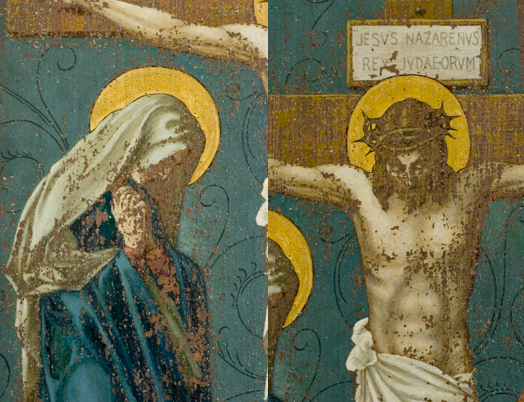 |
| Kathy, a collage by artist Chris Zahner |
If I were a Marvel Comics character, I'd want to be a superhero by night and an art conservator by day. It'd be nice to know that at the end of a day's work, I saved some lives and a few precious paintings. My real life doesn't come close to my comic book character, but I
recently connected with an artist who at least lives the life of my alter-ego. Boston-based artist
Chris Zahner (even sounds like an alter-ego name), works in art conservation. Since I really don't know much about art conservation, Chris was kind enough to answer a few of my questions.
How did you get into art conservation?
One of the many interesting aspects about the field is the seemingly endless ways people find it. Art conservation is a melding of art history, studio art and science, so people come from all kinds of backgrounds. Studio art is my angle. I have a BFA from the Cleveland Institute of Art in ceramics with a minor in drawing. Through the encouragement and support of a few conservator friends my interest in the field began. My first conservation job was at a regional lab in Cleveland called the
Intermuseum Conservation Association where I was the preparator in their paper department. I became hooked.
 |
| Chris at work. |
What does a typical day at your work look like?
Like most kids I wasn’t sure what I wanted to do when I grew up, but I had a really good sense of what I didn’t want. Boredom, monotony and cubicles were out. Challenges, problem solving, creativity and a life connected to the arts were in. So far art conservation has been the perfect job for me specifically because there are no “typical” days. One day might be spent logging hours in front of a computer writing reports while the following day might require you to put on a hard hat, climb scaffolding and clean a mural 30 feet up.
What are some things about art conservation that most people don't know?
People don’t realize there is a difference between conservation and restoration. Art conservation and restoration mainly differ in approach. A restorer makes an attempt to return an object as close to its original condition as possible, while the conservator’s primary goal is to prevent further deterioration even if the overall appearance might not look significantly different. Conservation is usually more of a light touch.
There is also a gulf between the two fields in terms of education. Art conservators have a Masters degree in a specific discipline such as paintings, paper, books, sculpture, photographs...etc. because of the increasingly technical nature of the profession. A restorer is generally an artisan and often a very skilled one, but lacks the formal training that a conservator would. That’s not to say there aren’t some very capable restorers out there who treat object with great care, but I would take your Old Master etching or first edition books to a conservator who specializes in that particular discipline.
 |
| Before and after pictures of one of Chris' conservation projects. |
What has been the most fascinating project you've worked on?
This might not be the most fascinating project I’ve worked on, but it might be one of the most dramatic. I received a phone call from a friend of mine who was a private paintings conservator in Dayton, Ohio asking me if I would be interested in helping him with a large project. A local chapel had hired him to help with their 14 station of the cross paintings. Painted by an art student from the Dayton Art Institute these paintings were executed on copper panels and showed various degrees of flaking and missing paint.
 |
| The brown color is the copper panel showing through. |
Flaking paint was attached to the panel using a heat activated adhesive. We filled in all the valleys where the paint was missing with a conservation putty to insure the painting would have a consistent plane when finished. All the white spots in the photo below represent where paint was totally missing.
Time for inpainting. Using conservation grade paints all the white areas and ONLY the white areas had to be reconstructed. You would never want to paint over existing paint, only the fills.
This piece is a good example of restoration as a conservation treatment. The painting has been stabilized, further flaking has been deterred and the inpainting does restore the work to something close to its original condition.
Do you have any practical advice for art collectors on how to take care of art?
Your home doesn’t need to be like a museum, but owning original artworks is a responsibility that should be taken seriously. There are conditions that have detrimental consequences to your work that you should be aware of. Light is no friend to paintings and objects on paper, so keep pieces out of direct sunlight and don’t use picture lights. UV glass or plexiglass is great when framing works on paper, but that’s not a green light to hang something across from that giant window in your home. Humidity and large fluctuations in temperature are also a problem, so don’t hang original works in your bathroom or over your fireplace. If you have concerns about specific objects in your home refer to the
American Institute for Conservation of Historic and Artistic Works.
Thanks, Chris, for the such a fascinating and informative interview! To see some of Chris' wonderful original art, check out his Etsy shop here. He also has a great art blog called Flopslump. (Catch a recent feature with yours truly here.)



















































